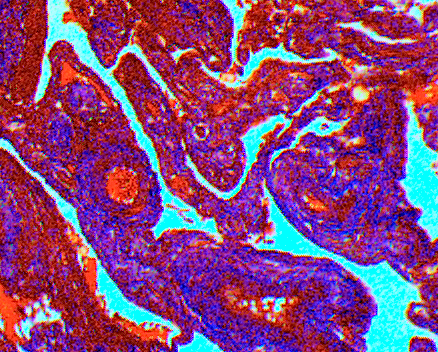The purpose of this stain is to differentiate between collagen & muscle. Muscle should stain red with collagen staining blue. Let’s take a look at the staining components and how they affect the stain. Two things that affect trichrome staining are fixation and differentiation.
First and foremost, fixation plays an important role in this stain. Bouin’s solution is the preferred fixative. Tissues fixed in NBF required post fixation in Bouin’s for proper staining. The acid pH is necessary to increase the selectivity of aniline blue for the collagen fibers. Recommended times for post fixing in Bouin’s vary from 1 hour at 56°C or overnight at room temperature. Please note that Bouin’s contains picric acid that is explosive when dry. Heating solutions that contain picric acid increases the potential of drying picric acid. Alternative suggested post fixation can be achieved with Gram’s iodine and citrate buffer.
Weigert’s iron hematoxylin is recommended for nuclear staining in trichromes. It is prepared fresh by mixing equal proportions of stock solution A, alcoholic hematoxylin, with solution B, acidified ferric chloride. Increasing the concentrations of Weigert’s iron hematoxylin stock solutions A from 1% to 2% hematoxylin and stock solution B from 29% to 62% will result in a darker nuclear stain.
The Biebrich scarlet-acid fuchsin stain mixture binds to all tissue components because of its small size. This includes both muscle & collagen. The phosphotungstic and phosphomlybdic acids selectively remove these dyes from collagen and also act as a mordant for the larger dye molecules of aniline blue. If the biebrich scarlet-acid fuchsin is insufficiently removed from the collagen the aniline blue stains poorly or not at all. Phospho acids work best when freshly prepared. If storage is necessary, refrigerate solutions. Phosphotungstic is unstable at a pH greater than 2.
Fading of Aniline blue staining of collagen can be caused by over differentiation of slides in 1% glacial acetic acid. Decreasing time and/or concentration in acetic acid may prevent fading.
References:
Luna LG (Ed.): Manual of Histologic Staining Methods of the Armed Forces Institute of Pathology, 3rd Edition. McGraw-Hill, New York, 1968
Yufeng Y, Chapman C. (2013) Masson Trichrome Stain: Postfixation Substitutes, Journal of Histotechnology, 26:2, 131-134,
Cheryl H. Crowder (1983) The Trichrome Stain: A Modification, Journal of Histotechnology, 6:3, 133-134,

